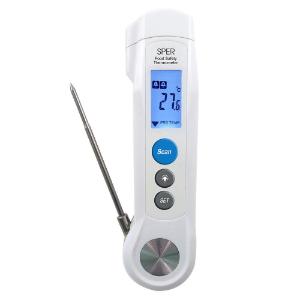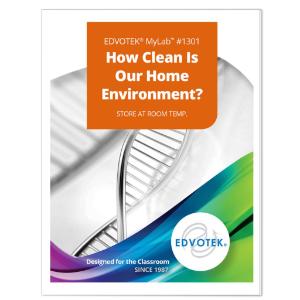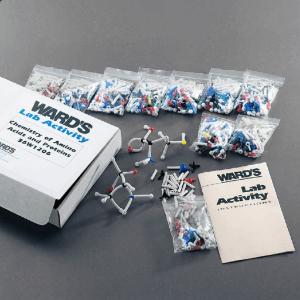Fowl Play: How Heat Kills the Bacteria in Your Thanksgiving Turkey
Whether it's brined, roasted, smoked, fried, spatchcocked, grilled, or slow-cooked, the bird is the belle of the ball on Thanksgiving. That kind of spotlight makes most home cooks nervous about getting it just right. But let's talk turkey; the biggest risk comes from undercooking the meat. The U.S. Department of Agriculture (USDA) publishes safe cooking guidelines to makes sure we feast on a delicious but, more importantly, a safe turkey.
Preparation of the holiday meal can be a perfect way to capture the interest of your students. Food safety can be used to engage students in inquiry-based science. The students in your class will be fascinated by learning how bacteria and denatured proteins are connected to their holiday meal's safety. It's a great way to link your lesson plans on food safety and nutrition to students' everyday lives.
What are some of the key concepts related to food safety and preparing the big bird for the holiday meal?
Food Pathogens
Americans eat more chicken every year than any other meat.1. Chicken and turkey are quite nutritious. But, when raw, these meats are often contaminated with Campylobacter bacteria and sometimes with Salmonella and Clostridium perfringens bacteria. Yech! That explains why eating undercooked poultry can give you food poisoning. The home cook’s mission is to make a tasty bird while obliterating those nasty bugs.
Bacteria thrive and grow in the temperature ranges between 40 °F and 140 °F, doubling in number in as little as 20 minutes. It's so risky that the USDA calls this range the “Danger Zone.”
That's why it's important to keep meat refrigerated or cook it at high temperatures. Some people think freezing meat kill germs, but that's a myth. Freezing only makes the germs dormant until they are thawed and become ready to pounce again if not handled properly.
How does heat destroy bacteria?
The USDA reports that heating poultry to at least 165°F destroys Salmonella, Campylobacter bacteria, and avian influenza viruses. That's because, above a certain temperature, the bacteria’s cell will collapse and die.
Bacteria contain various proteins. Proteins have precise shapes. They start as long strands, then fold into helixes, hairpins, and other configurations, depending on the sequence of their components. These shapes play a huge role in what proteins do.2 Heat kills bacteria by denaturing these essential proteins.
As the temperature rises, the weakest bonds that keep protein structures together start to break, followed by the stronger bonds with rising temperatures.
What happens to protein structures during denaturation?
During the denaturation process, proteins or nucleic acids lose the quaternary, tertiary, and secondary structures which are present in their native state when exposed to external stress or compounds like a strong acid or base, a concentrated inorganic salt, an organic solvent (e.g., alcohol or chloroform), radiation or heat.3 If proteins in a living cell are denatured, this results in disruption of cell activity and, hopefully, bacteria death in our turkey.
Functional proteins have four levels of structural organization: 1) Primary structure: the linear structure of amino acids that make up the polypeptide chain 2) Secondary structure: regular, repeated patterns of folding of the protein backbone. Hydrogen bonds between peptide group chains in an alpha helix or beta sheet are the most common 3) Tertiary structure: three-dimensional structure of alpha helixes and beta helixes folded 4) Quaternary structure: three-dimensional structure of multiple polypeptides and how they’re packed together.
Credit: Scurran15 - Own work, CC BY-SA 4.0
Heat destroys the quaternary, tertiary, and secondary structures of protein, destroying the building blocks of the cell membrane and leaking out cytosolic contents of the cell. In the secondary and tertiary structures, the heat increases the kinetic energy and causes the molecules to vibrate so rapidly and forcefully that the bonds are disrupted. The high temperature also disrupts the base stacking interaction in DNA and RNA of cells. Finally, the saturated lipids in the cell membrane, upon heating, the bilayer membrane is destroyed.
Denaturation reactions aren't strong enough to break the peptide bonds, so the primary structure (sequence of amino acids) remains the same after a denaturation process.
Credit: Scurran15 - Own work, CC BY-SA 4.0
The CDC estimates that every year, approximately one-sixth of the U. S. population has mild to severe illnesses caused by pathogens in food — and more than 3,000 people die from them. Learning food safety science will help your students better understand decisions and practices that may affect their health. It could also encourage them to step up to the plate and take an active role in preventing foodborne illness.
There's a lot to digest for students exploring the science of food safety. Armed with your lessons, they'll understand why the USDA instructs cooks to turn up the heat when preparing the Thanksgiving turkey. At Ward's, we hope you and your students have a lovely holiday with your families. Happy Thanksgiving!
1. Chicken and Food Poisoning | CDC. https://www.cdc.gov/foodsafety/chicken.html 2. https://www.quantamagazine.org/how-heat-kills-cells-20170509 3. Denaturation (biochemistry) - Wikipedia. https://en.wikipedia.org/wiki/Denaturation_(protein)
Recommended products:
[StartProductBlock]

Food Safety Thermometer with IR, Sper Scientific
HACCP compliant surface and internal temperature. The built-in bright white flashlight helps illuminate the surface being measured. Gives surface and internal temperature readings. Check the surface temperature of food instantly using infrared technology.
[EndProductBlock]
[StartProductBlock]

MyLab How Clean is our Home Environment
Single student kit ideal for remote learning solution; teach students about the ubiquity of bacteria right at home. Students can test the efficacy of household cleaners at killing bacteria and how cleaning affects microbial growth.
[EndProductBlock]
[StartProductBlock]

Ward's® Chemistry of Amino Acids and Proteins Lab Activity
Illustrate the structure of a protein in three dimensions. Students form a polypeptide to learn about peptide bonds, protein structure, and protein synthesis and explore the general structure and composition of amino acids.
[EndProductBlock]
